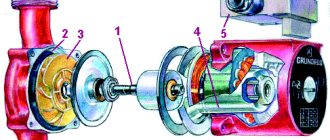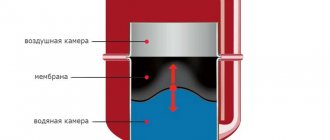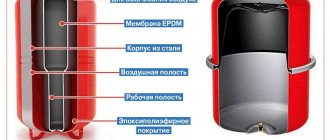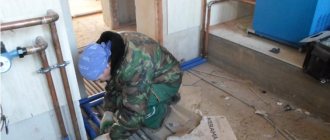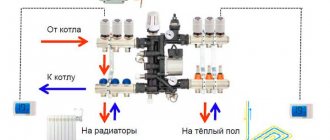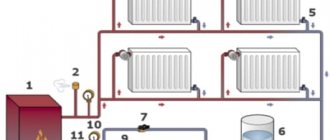In the recent past, the heating system has had shortcomings. The heating did not work if one part was poorly adjusted, but when it was adjusted, the balancing of the entire system was lost. The difficult task was to find pumps for this system, and the boilers had thermal fluctuations inside. But today, a hydraulic heating arrow can cope with the problems that arise when connecting the boiler to the heating system.
The use of hydraulic arrows with solid fuel equipment
When using a solid fuel unit, the hydraulic separator is connected at the inlet-outlet point.
This option for connecting different types of heating devices ensures the selection of optimal and individual temperature conditions for all components separately. Today, consumers, having understood how a hydraulic heating device works, prefer ready-made products that are on sale. Select a hydraulic separator from the catalog, based on the power of the unit and the maximum water flow.
Hydraulic separator - purpose
A hydraulic separator also known as anuloid , also known as a hydraulic arrow , or a thermostatic separator, is designed for hydraulic separation of two circuits of coolant movement in heating systems.
Just an example. The house has a heating boiler with a flow rate of 30 l/min. The heating system flow rate is calculated as 100 l/min. In order not to “strain” the boiler up to 100 liters, create two loops for the boiler and for heating, which are separated by an anuloid (separator).
DIY thermal separator
The design of the hydraulic arrow is so simple that it allows the owner of a country house to assemble it himself without much difficulty. An important manufacturing stage is the correct calculation of the diameters of the nozzles and separator. The simple design of the unit follows the rule of 3 diameters.
It is possible to make a hydraulic arrow yourself
In this case, the diameter of the pipe is taken as a basis, which is the same for all inlet and outlet circuits. The total diameter of the hydraulic arrow will be equal to 3 diameters of the pipe, and its length should be 4 diameters of the separator. The axes of the inlet and outlet pipelines will be located from the ends of the structure at a distance of one diameter of the thermal separator.
This size ratio allows you to reduce the speed of movement of the coolant to the desired results. In the future, you just need to select pipes of suitable sizes and carry out welding work. This simple design will work successfully in small heating systems.
Operating principle of the hydraulic boom:
How to calculate a hydraulic arrow: its operating principle and characteristics
More recently, the heating system had shortcomings. The heating did not work when one of the components was poorly adjusted, but when it began to be adjusted, the balance of the entire system was disrupted. I had to start all over again.
The only size when choosing a hydraulic boom is the diameter of the supply pipes. The highest recommended speed of water movement through the hydraulic arrow is about 0.2 m/sec.
It was difficult to find pumps for this system, and the boilers had internal thermal fluctuations. Currently, a hydraulic heating arrow helps to cope with the problems that arise when starting up the heating system.
Characteristics of the hydraulic gun:
- Water supply procedure;
- Location of incoming and outgoing pipes;
- Method of water drainage;
- System capacity.
The hydraulic arrows may differ in appearance, but the essence is the same for all of them. It's just a pipe with pipes welded to it. For a hydraulic arrow, a pipe with a round cross-section is suitable, but also with a square one. Injection and outgoing pipelines are connected to the nozzles. The heating order is divided into circuits. The small circuit is the boiler - the hydraulic arrow, the large circuit is the boiler - the hydraulic arrow - the consumer.
What should you know?
The hydraulic arrow is an additional unit, which is located in a vertical position. It is made in the form of a cylinder, but can also have a cross-section in the form of a rectangle. This device is fitted with pipes that connect to the boiler, as well as to the heat exchange circuits. This device divides a small circuit, as well as extended heating circuits. Traditional hydraulic divider designs are often used.
Device diagram
Such a device maintains temperature and hydraulic balance. With its help, you can achieve small pressure losses, as well as thermal energy and productivity. The design allows you to increase the efficiency of the heating system and reduce resistance in the system.
Important characteristics include the diameters of the pipes and the main device. The remaining parameters can be found in the standard diagrams.
Built-in hydraulic catcher
The program has some nuances:
When calculating, the power of the heating equipment must be used
To determine this indicator, you can also use a special calculation program; An important characteristic is the speed of movement of the coolant in the vertical direction. The lower this indicator, the better the coolant will get rid of gases and sludge
Also in this case, there will be a smoother mixing of the cooled and hot flows. The best option is 0.1-0.2 m/s. In the program you can select the required parameter; A special characteristic is the operating mode of the entire structure. In this case, the temperature levels in the line passing from the heating device are taken into account. All indicators are entered into the calculator.
A special calculation formula is provided in the applied calculation algorithm. As a result, a result will be shown that will show the suitable diameter for the hydraulic arrow, as well as the cross-section of the pipes used. The remaining parameters of the linear type are even easier to determine.
Before you begin installing such a device, it is worth studying all the functions of the hydraulic arrow.
Related article:
Save time: selected articles delivered to your inbox every week
Let's look at how to calculate the hydraulic arrow of a heating system
The hydraulic arrow is an integral component of the heating system. Thanks to this device, the pressure in the system is regulated and temperature changes in it are eliminated.
To ensure that the boiler of the heating system operates smoothly and more economically, a hydraulic arrow is used. Achieving hydraulic balance of the system without this element will be a very difficult task.
When selecting a hydraulic needle, you need to pay attention to such a parameter as maximum power. This indicator can be from 50 kW to 300 kW. You also need to know that these devices are designed to work with different numbers of circuits. On average, their number ranges from 3 to 5 circuits. The diameter of the hydraulic needle is also an important indicator. It increases in direct proportion to the power of the boiler room and the complexity of the heating system. The body of the hydraulic gun is usually made of steel. To increase service life, stainless steel is used. The use of a hydraulic arrow has a number of advantages, which were appreciated by those who installed it in their heating system. The hydraulic arrow for the heating system, which is used in modern installations, makes it possible to avoid many problems that may arise during operation.
Advantages of the hydraulic arrow:
- Combines heating circuits;
- Ensures good operation of devices;
- Does not allow temperature changes;
- Extends the life of equipment;
- Prevents the “thermocline” phenomenon.
The most dangerous thing in a heating system is the “thermocline”. This phenomenon occurs when there is a sharp jump in temperature when hot and cold water come into contact. This can greatly harm the boiler. But this can be avoided if a hydraulic separator is installed in the heating system. It is safe to say that the program to ensure the safety of the heating system with a hydraulic arrow is being fully implemented.
Popular manufacturers
There are not as few companies involved in the production of hydraulic separators for heating networks as it might seem at first glance. However, today we will get acquainted with the products of only two companies, GIDRUSS and Atom LLC, since they are considered the most popular.
Table. Characteristics of hydraulic separators manufactured by GIDRUSS.
| Model, illustration | Main characteristics |
| 1. GR-40-20 | — the product is made of structural steel; — designed for one consumer; — minimum power of the heating device is 1 kilowatt; — its maximum power is 40 kilowatts. |
| 2. GR-60-25 | — the product is made of structural steel; — designed for one consumer; — the minimum power of the heating device is 10 kilowatts; — its maximum power is 60 kilowatts. |
| 3. GR-100-32 | — the product is made of structural steel; — designed for one consumer; — minimum power of the heating device is 41 kilowatts; — its maximum power is 100 kilowatts. |
| 4. GR-150-40 | — the product is made of structural steel; — designed for one consumer; — minimum power of the heating device is 61 kilowatts; — its maximum power is 150 kilowatts. |
| 5. GR-250-50 | — the product is made of structural steel; — designed for one consumer; — the minimum power of the heating device is 101 kilowatts; — its maximum power is 250 kilowatts. |
| 6. GR-300-65 | — the product is made of structural steel; — designed for one consumer; — minimum power of the heating device is 151 kilowatts; — its maximum power is 300 kilowatts. |
| 7. GR-400-65 | — the product is made of structural steel; — designed for one consumer; — minimum power of the heating device is 151 kilowatts; — its maximum power is 400 kilowatts. |
| 8. GR-600-80 | — the product is made of structural steel; — designed for one consumer; — minimum power of the heating device is 251 kilowatts; — its maximum power is 600 kilowatts. |
| 9. GR-1000-100 | — the product is made of structural steel; — designed for one consumer; — minimum power of the heating device is 401 kilowatts; — its maximum power is 1000 kilowatts. |
| 10.GR-2000-150 | — the product is made of structural steel; — designed for one consumer; — minimum power of the heating device is 601 kilowatts; — its maximum power is 2000 kilowatts. |
| 11. GRSS-40-20 | — the product is made of AISI 304 stainless steel; — designed for one consumer; — minimum power of the heating device is 1 kilowatt; — its maximum power is 40 kilowatts. |
| 12. GRSS-60-25 | — the product is made of AISI 304 stainless steel; — designed for one consumer; — the minimum power of the heating device is 11 kilowatts; — its maximum power is 60 kilowatts. |
| 13. GRSS-100-32 | — the product is made of AISI 304 stainless steel; — designed for one consumer; — minimum power of the heating device is 41 kilowatts; — its maximum power is 100 kilowatts. |
Let us also note that each hydraulic arrow for heating listed above also performs the functions of a kind of sump. The working fluid in these devices is cleared of various types of mechanical impurities, which significantly increases the service life of all moving components of the heating system.
Hydraulic separator dimensions
The height of the hydraulic separator can be any. Depends on the installation location. The minimum diameter of the hydraulic separator is determined by the formula:
According to the formula, everything is very simple:
- Speed of liquid movement in the separator: 0.1 m/s;
- Flow W is the difference between the boiler circuit and the heating system circuit. We calculate costs based on the maximum flow rates of the pumps according to the passport.
Example.
- Boiler circuit flow 30 l/min;
- Heating circuit flow 80 l/min.
- Flow difference W: 80-30=50 l/min.
- Pi = 3.14;
- Speed V=0.1 meter\second.
We count:
50 liters÷60 seconds=0.833 l/sec;
- 1 liter=0.001 m3;
- 0.833 liters/sec=0.000833 cubic meters/sec;
- D=0.102 measures=102 mm.
So, we found that the diameter of the separator should not be less than 102 mm .
The role of the hydraulic arrow in modern heating systems
In order to find out what a hydraulic arrow is and what functions it performs, first we will get acquainted with the features of the operation of individual heating systems.
Simple option
The simplest version of a heating system equipped with a circulation pump will look something like this.
Of course, this diagram is significantly simplified, since many network elements in it (for example, the security group) are simply not shown in order to “make the picture easier to understand.” So, in the diagram you can see, first of all, a heating boiler, thanks to which the working fluid is heated. Also visible is a circulation pump, through which the liquid moves through the supply (red) pipeline and the so-called “return”. Typically, such a pump can be installed both in the pipeline and directly in the boiler (the latter option is more typical for wall-mounted devices).
Note! There are also heating radiators in the closed circuit, thanks to which heat exchange occurs, that is, the generated heat is transferred to the room. If the pump is correctly selected in terms of pressure and performance, then it alone will be quite sufficient for a single-circuit system, therefore, there is no need to use other auxiliary devices
If the pump is correctly selected in terms of pressure and performance, then it alone will be quite sufficient for a single-circuit system, therefore, there is no need to use other auxiliary devices.
More complex option
If the area of the house is large enough, then the diagram presented above will clearly not be enough for it. In such cases, several heating circuits are used at once, so the diagram will look slightly different.
Here we see that through the pump, the working fluid enters the manifold, and from there it is transferred to several heating circuits. The latter include the following elements.
- A high temperature circuit (or several), in which there are collectors or ordinary batteries.
- DHW systems equipped with an indirect heating boiler. The requirements for the movement of working fluid are special here, since the temperature of water heating in most cases is regulated by changing the flow rate of the fluid passing through the boiler.
- Warm floor. Yes, the temperature of the working fluid for them should be an order of magnitude lower, which is why special thermostatic devices are used. Moreover, the contours of the heated floor have a length significantly exceeding the standard wiring.
It is quite obvious that one circulation pump cannot cope with this kind of load. Of course, today high-performance models with increased power are sold, capable of creating quite high pressure, but it is worth thinking about the heating device itself - its capabilities, alas, are not limitless. The fact is that the boiler elements are initially designed for certain pressure and performance indicators. And these indicators should not be exceeded, as this can lead to breakdown of the expensive heating installation.
In addition, the circulation pump itself, operating at the limit of its capabilities in order to supply all circuits of the network with liquid, will not be able to last long. What can we say about the loud noise and electrical energy consumption. But let's return to the topic of our article - to the hydraulic arrow for heating.
Why do you need a hydraulic arrow: principle of operation, purpose and calculations
Many heating systems in private households are unbalanced. The hydraulic arrow allows you to separate the circuit of the heating unit and the secondary circuit of the heating system. This improves the quality and reliability of the system.
Features of the device
When choosing a hydraulic gun, you need to carefully study the principle of operation, purpose and calculations, and also find out the advantages of the device:
- the separator is necessary to ensure that the technical specifications are met;
- the device maintains temperature and hydraulic balance;
- parallel connection ensures minimal losses of thermal energy, productivity and pressure;
- protects the boiler from thermal shock and also equalizes circulation in the circuits;
- allows you to save fuel and electricity;
- a constant volume of water is maintained;
- reduces hydraulic resistance.
Operation of the device with a four-way mixer
The operating features of the hydraulic switch make it possible to normalize hydrodynamic processes in the system.
Helpful information! Timely removal of impurities allows you to extend the service life of meters, heating devices and valves.
Hydraulic heating device
Before you buy a hydraulic arrow for heating, you need to understand the structure of the structure.
Internal structure of modern equipment
The hydraulic separator is a vertical vessel made of large diameter pipes with special plugs at the ends. The dimensions of the structure depend on the length and volume of the circuits, as well as on the power. In this case, the metal case is installed on support posts, and small-sized products are mounted on brackets.
Connection to the heating pipeline is made using threads and flanges. The material used for the hydraulic arrow is stainless steel, copper or polypropylene. In this case, the body is treated with an anti-corrosion substance.
Note! Polymer products are used in a system with a boiler with a capacity of 14-35 kW. Making such a device with your own hands requires professional skills.
Additional equipment functions
The principle of operation, purpose and calculations of the hydraulic arrow can be learned and performed independently. The new models have the functions of a separator, separator and temperature regulator. A temperature control valve provides a temperature gradient for the secondary circuits. Removing oxygen from the coolant reduces the risk of erosion of the internal surfaces of equipment. Removing excess particles increases impeller life.
Inside the device there are perforated partitions that divide the internal volume in half. This does not create additional resistance.
The diagram shows a sectional view of the device
Helpful information! Complex equipment requires a temperature sensor, a pressure gauge and a line to power the system.
The principle of operation of a hydraulic arrow in heating systems
The choice of hydraulic arrow depends on the speed of the coolant. In this case, the buffer zone separates the heating circuit and the heating boiler.
There are the following hydraulic arrow connection diagrams:
neutral operating scheme, in which all parameters correspond to the calculated values. At the same time, the design has sufficient total power;
Using a heated floor circuit
a certain scheme is used if the boiler does not have sufficient power. If there is insufficient flow, an admixture of cooled coolant is required. When there is a temperature difference, thermal sensors are triggered;
Heating system diagram
the flow volume in the primary circuit is greater than the coolant consumption in the secondary circuit. In this case, the heating unit operates in optimal mode. When the pumps in the second circuit are turned off, the coolant moves through the hydraulic valve along the first circuit.
Option for using a hydraulic arrow
The performance of the circulation pump should be 10% greater than the pressure of the pumps in the secondary circuit.
Features of the system
This table shows some models and their prices.
Function performed
The hydraulic needle is an integral component of the heating system, which represents forced circulation and pumps on the combs of all elements.
The hydraulic arrow ensures smooth operation of the heating boiler - this is the main function of this device.
Thanks to the arrow, changes in temperature and pressure can be avoided; it also prevents thermal clicks (cold water flows in reverse while hot water is supplied at the same time), which has a bad effect on the performance of the boiler, only if it is cast iron.
The hydraulic arrow is made from a certain type of pipe (mostly square). The design has an air vent.
The system includes circuits such as:
- small (boiler, hydraulic gun);
- large (for example, a heat pump).
Calculation method
To make a hydraulic arrow for heating with your own hands, you will need preliminary calculations. This figure shows the principle by which the dimensions of a device can be calculated quickly, with fairly high accuracy.
"3d" principle
These proportions were obtained taking into account the results of experiments and the efficiency of the device in different modes. The value of D, which consists of three d, can be calculated using the following formula:
- РВ – water consumption in cubic meters;
- SP – water flow speed in m/s.
In order to fulfill the optimal conditions mentioned above, the value SP = 0.1 is inserted into the formula. The flow rate in this device is calculated by the difference Q1-Q2. Without measurements, these values can be found using data from the technical data sheets of the circulation pumps of each circuit.
Calculator for calculating hydraulic pump parameters based on pump performance
Hydraulic separator - how it works
The separator divides the heating system into at least two parts. One loop relates to the heating boiler, the second loop connects the heating wiring of the house. A circulation pump is installed in each loop.
How the separator works
We have two heating loops (circuits). Loop K1 with pump N1 and loop K2 with pump N2. The flow rate in loop K1 is equal to W1, and the flow rate in loop K2 is equal to W2.
- If W1=W2, then the circuits are mixed in the circuit separator, forming a single heating system, without separation along circuits;
- If W1
- If W1>W2, then the coolant moves from top to bottom.
Pump N1 creates a flow rate in the first loop equal to W1. Pump N2 creates a flow rate in the second loop equal to W2.
Manufacturers and prices
It will be easier to buy a hydraulic arrow for heating after reading the data from the following table. Current price offers can be clarified immediately before purchasing the product. But this information will be useful for comparative analysis, taking into account the different characteristics of products.
Table 1. Characteristics and average cost of hydraulic guns
| Image | Equipment model | Heating system power in kW (maximum) | Price in rub. | Notes |
| GR-40-20, Gidruss (Russia) | 40 | 3 600 — 3 800 | The cubic case is made of carbon steel with anti-corrosion coating, the simplest model. | |
| GRSS-60-25, Gidruss (Russia) | 60 | 9 800 — 10 600 | Stainless steel body, six nozzles, built-in mesh for separation and a set of mounting brackets as standard. | |
| TGR-60-25x5, Gidruss (Russia) | 60 | 10 300 — 11 800 | Housing made of low-alloy steel, possibility of connecting up to 4 external circuits + heating. | |
| GRSS-150-40, Gidruss (Russia) | 150 | 15 100 — 16 400 | Stainless steel, 6 pipes. | |
| MH50, Meibes (Germany) | 135 | 54 600 — 56 200 | Complex design with built-in devices for removing sludge and air. |
Modern hydraulic gun
From the table it is clear that the cost, in addition to general technical parameters, is influenced by the following factors:
- body material;
- possibility of connecting additional circuits;
- design complexity;
- availability of additional equipment;
- manufacturer's name.
Cross-section of hydraulic arrow
It’s easy to find out what’s hidden inside the hydraulic arrow; just look at it in cross-section. In those copies that are made independently, there are no “internals”. Hollow tank without any quirks.
Companies that produce hydraulic arrows professionally introduce useful additions to its design. For example, our supplier Gidruss has recently been equipping switches with separators. A stainless steel mesh permeates the entire length of the product, which is an absolute advantage in the fight against excess air.
Foreign brands use similar gadgets
Using a hydraulic arrow together with a manifold and solving other problems
Installation of a hydraulic arrow in a connection diagram with several heating junctions is carried out using a special switchgear. The manifold consists of two separate parts with pipes. Shut-off valves, measuring and other devices are connected to them.
Hydraulic arrow in a single unit with a manifold
To connect solid fuel boilers, it is recommended to increase the volume of the hydraulic compensator. This will create a protective barrier that prevents a sharp increase in temperature in the system. Such jumps in parameters are typical for aging equipment.
If there is a shift in height of the outlet pipes, the movement of the liquid slows down somewhat, and the path increases. This upgrade in the upper part improves the separation of gas bubbles, and in the lower part it is useful for collecting debris.
Connecting several different consumers
This connection of several circuits provides different temperature levels. But we must understand that it is impossible to obtain exact values of heat distribution in dynamics. For example, approximately equal consumption values of Q1 and Q2 will lead to the fact that the temperature difference in the circuits of radiators and heated floors will be insignificant.
What is a hydraulic arrow needed for and what functions does it perform in the heating system?
Such a device can perform several functions - both primary and additional. It all depends on the design and manufacturing option. Let's try to understand why a hydraulic arrow is needed in a heating system.
Main function of hydraulic separator
The main task of such a device is to distribute flows along the circuits. At the same time, the hydraulic gun is quite capable of working not only with several circuits, but also with a cascade of boilers, providing the necessary and uniform heating of the radiators of a particular room. With the correct location of the pipes, such a device can direct a slightly heated coolant to heated floors, a hotter one to some rooms and a very heated one to others. It all depends on the wishes of the homeowner.
Stainless steel products are durable and aesthetically pleasing
Related article: Which heating radiators for an apartment are best to choose among all the variety presented on the heating systems market? Let's try to understand the main criteria for choosing heating devices in this material.
A hydraulic separator in a heating system is only needed if there are many radiators and several circuits. If single-circuit heating is installed in a small house, there is no need to install it.
Additional switchgear options
An additional function of a capacitive hydraulic separator is to remove oxygen dissolved in it from the coolant, which contributes to corrosion of system parts. It also settles heavy particles of rust and lime, which will inevitably be carried by the coolant.
Some models that can be purchased in stores are equipped with special coarse filters, as well as so-called deaerators.
With so many circuits it is impossible to do without a hydraulic separator
Conclusions and recommendations
To make a hydraulic arrow from polypropylene with your own hands, you will need a special soldering iron. To work with metals, you will need welding equipment and appropriate skills. Despite the large number of instructions on the Internet, it will be difficult to make high-quality products. Taking into account all the costs and difficulties, it is more profitable to purchase a ready-made device in a store.
With the help of knowledge about hydraulic arrows, principles of operation, purpose and calculations, a specific model is selected. The characteristics of boilers and heat consumers are taken into account.
To create complex systems, you can seek help from specialized specialists
Save time: selected articles delivered to your inbox every week
Making a hydraulic arrow for heating with your own hands: work flow diagram
It is unlikely that it will be possible to make a hydraulic arrow from polypropylene without certain skills on your own. It is quite difficult to solder the taps and the body together at home, although this is possible. If a home craftsman is well acquainted with the technology of welding such materials and has the necessary equipment, then he is quite capable of doing such work with his own hands. A hydraulic arrow made of polypropylene will last much longer than a steel product.
Both the collector and the hydraulic arrow are made by hand
But a home craftsman with welding skills can make such a product from metal. Moreover, such work does not require special knowledge.
First of all, after making the necessary calculations, which are more convenient to perform using the online calculators we provide, you need to draw up a drawing of the hydraulic arrow with your own hands. Be sure to indicate all dimensions on it. After this, pipes of the required diameter are selected.
The main pipe, which will serve as a separator, is welded with plugs on both sides, and holes for pipes in the required quantity are burned along its length, according to measured dimensions. Sections of thinner pipes are welded into the main one, thus creating bends for the boiler supply and return, as well as for the circuits.
Ready-made hydraulic separator with manifold. All that remains is to paint and install
Helpful information! Do not forget about the need to control the pressure in the hydraulic arrow and ensure the possibility of bleeding air from it. For this, it is also worth providing for bends. It is important to install a drain screw at the very bottom of the cylinder, which will allow you to periodically clean the system.
What is a hydraulic arrow for heating
In complex branched heating systems, even high-power pumps will not be able to meet the different parameters and operating conditions of the system. This will negatively affect the functioning of the boiler and the service life of expensive equipment. In addition, each of the connected circuits has its own pressure and performance. This leads to the fact that the entire system cannot work coherently at the same time.
Even if each circuit is equipped with its own circulation pump, which will meet the parameters of the given line, the problem will only get worse. The entire system will become unbalanced because the parameters of each circuit will differ significantly.
To solve the problem, the boiler must produce the required volume of coolant, and each circuit must take exactly as much as needed from the collector. In this case, the collector serves as a hydraulic system separator. It is precisely in order to separate the “small boiler” flow from the general circuit that a hydraulic separator is needed. Its second name is hydraulic arrow (HS) or hydraulic arrow.
The device received this name because, just like a railway switch, it can separate coolant flows and direct them to the desired circuit. This is a rectangular or round tank with plugs at the ends. It is connected to the boiler and manifold and has several embedded pipes.
Operating principle of hydraulic separator
The coolant flow passes through the hydraulic separator for heating at a speed of 0.1-0.2 meters per second, and the boiler pump accelerates the water to 0.7-0.9 meters. The speed of the water flow is damped by changing the direction of movement and the volume of passing liquid. In this case, heat loss in the system will be minimal.
The principle of operation of the hydraulic needle is that the laminar movement of the water flow practically does not cause hydraulic resistance inside the housing. This helps maintain flow speed and reduce heat loss. This buffer zone separates the consumer circuit and the boiler. This facilitates autonomous operation of each pump without disturbing the hydraulic balance.
Operating modes
The hydraulic arrow for heating systems has 3 operating modes:
- In the first mode, the hydraulic separator in the heating system creates equilibrium conditions. That is, the flow rate of the boiler circuit does not differ from the total flow rate of all circuits that are connected to the hydraulic arrow and the manifold. In this case, the coolant does not linger in the device and moves horizontally through it. The temperature of the coolant at the supply and discharge pipes is the same. This is a rather rare operating mode in which the hydraulic arrow does not affect the operation of the system.
- Sometimes a situation occurs when the flow rate on all circuits exceeds the boiler capacity. This happens at maximum fluid flow by all circuits at once. That is, the demand for coolant exceeded the capabilities of the boiler circuit. This will not lead to a stop or imbalance of the system, because a vertical upward flow will form in the hydraulic arrow, which will ensure the admixture of hot coolant from the small circuit.
- In the third mode, the thermometer for heating works most often. In this case, the flow rate of the heated liquid in the small circuit is higher than the total flow rate on the collector. That is, demand in all circuits is lower than supply. This will also not lead to imbalance of the system, because a vertical downward flow is formed in the device, which will ensure that the excess volume of liquid is discharged into the return line.
Additional features of the hydraulic gun
The principle of operation of a hydraulic separator in a heating system described above allows the device to implement other capabilities:
After entering the separator body, the flow rate decreases, this leads to the sedimentation of insoluble impurities contained in the coolant. To drain the accumulated sediment, a tap is installed at the bottom of the hydraulic arrow. By reducing the speed of the ceiling, gas bubbles are released from the liquid, which are removed from the device through an automatic air vent installed in the upper part. In essence, it acts as an additional separator in the system
It is especially important to remove gas at the boiler outlet, because when the liquid is heated to high temperatures, gas formation increases. The hydraulic separator is very important in systems with cast iron boilers. If such a boiler is connected directly to the collector, then cold water entering the heat exchanger will lead to the formation of cracks and equipment failure.
Hydraulic switches, manifolds and manifold cabinets, pump groups
Hydraulic arrow - used for hydraulic separation of flows. It makes the heating circuits dynamically independent when transferring the movement of the coolant, but at the same time transfers heat well from one circuit to another. Hence another name for the hydraulic arrow - hydraulic separator.
WHY DO YOU NEED A HYDRAULIC SWITCH?
To obtain, with a low coolant flow rate in the boiler circuit, a high flow rate in the second circuit, for example, in the radiator circuit. Let’s say there is a boiler with a flow rate of 50 liters per minute, and the heating system turns out to have twice the flow rate - 100 liters per minute.
In this case, it is not economically feasible to accelerate the boiler circuit to a flow rate greater than that provided by the manufacturer, because the hydraulic resistance will increase, which will either not provide the required flow rate, or will increase the load on the circulation pump and, accordingly, additional energy costs.
A hydraulic arrow is needed to eliminate the hydrodynamic influence of the circuits on each other and on the overall hydrodynamic balance of the entire heating system.
For example, if you have heated floors, radiator heating and a hot water supply circuit (indirect heating boiler), then it makes sense to divide these flows into separate circuits so that they do not influence each other.
The absence of hydrodynamic influence in the hydraulic arrow between circuits is when the movement (speed and flow) of the coolant in the hydraulic arrow is not transmitted from one circuit to another. Hydraulic distributors (hydraulic separators, hydraulic separators) are usually used in heating systems consisting of several consumers with their own special circulation and temperature conditions. For example: the system consists of an indirect heating boiler, a main heating circuit, heated floors, there are two or more boilers in the system, etc.
- Their main purpose: removing unnecessary loads from circulation pumps, preventing heat strokes, and ultimately saving money.
- ADVANTAGES OF USING HYDRAULIC JOINTS.
The selection of circulation pumps is greatly simplified. Correct selection of pumps for a complex heating system is not an easy task: primary (boiler circuit) pumps may not provide the required performance, for example: a primary circuit circulation pump has a lower performance than secondary (heating) circuit pumps.
The hydraulic arrow will provide you with cost savings. In systems without a hydraulic separator, low-power pumps will expend a lot of energy to overcome the influence of larger pumps, the influence of additional circuits can cause the pumps to operate in suboptimal or abnormal conditions. As a result, the pumps may fail.
Due to the elimination of mutual influence of pumps, the operating mode and durability of boiler equipment are improved. The heating system operates most of the time under conditions far from the design ones that were used in the design. For example, the use of flow control devices in zone heating systems leads to imbalance.
READ MORE: Types of wallpaper - a brief overview with photo design, recommendations for selection, quantity calculation
when any circuits are disconnected from the heating system, a small flow rate of coolant occurs in the boiler, which leads to a sharp increase in temperature in the boiler and the subsequent arrival of very cooled coolant. The hydraulic arrow helps maintain a constant boiler flow rate, which reduces the temperature difference between the supply and return pipelines.
- Commercially available hydraulic separators can be used as effective sludge and air removers from the system.
- IS A HYDRAULIC SWITCH NEEDED OR NOT IN A SPECIFIC CASE?
- System without hydraulic separator
You have decided to install two boilers, gas and electric (or solid fuel and electric), so that they work in pairs for one heating system. The electric boiler was chosen as an “insurance” boiler in case of lack of power of the main one. Answer: necessary. Each boiler has its own pump, and so that they do not conflict with each other, they must be hydraulically separated.
If you have a complex heating system, for example, an indirect heating boiler, a heated floor, a circuit of heating radiators with its own circulation pumps are used simultaneously, then yes, a hydraulic arrow is needed. It can be said more simply: if you have one boiler, and more than one consumer (radiators, heated floors and also, say, an indirect heating boiler), a hydraulic arrow will have to be installed: it will ensure minimal resistance to circulation through the boiler with different or minimal heat dissipation at the collector.
Is a hydraulic arrow (hydraulic separator) needed for a wall-mounted double-circuit boiler if it simply heats some radiators, and hot water is taken from the second circuit?
Answer: not needed. Is a hydraulic arrow necessary when using a solid fuel boiler?
Answer: yes, it is necessary. And the larger the volume, the better. And for what? To equalize temperature fluctuations for the heating system! A solid fuel boiler can produce very unpleasant temperature surges for the system.
Hydraulic separator system
PRINCIPLE OF OPERATION OF HYDRAULIC SEPARATOR (HYDRAULIC SEPARATOR)
picture 1
Circulation pump H1 creates coolant circulation through the hydraulic arrow along the first circuit, and pump H2 circulates through the second circuit. Those. The coolant is mixed in the hydraulic arrow.
But if the flow rate Q1 = Q2, then mutual penetration of the coolant from circuit to circuit occurs, thereby creating one common circuit. In this case, vertical movement in the hydraulic arrow does not occur.
In cases where Q1{amp}gt;Q2, the movement of the coolant in the hydraulic arrow occurs from top to bottom and vice versa, in cases where Q1{amp}lt; Q2, the coolant moves in the hydraulic arrow from bottom to top.
In general, if your system operates at high temperatures (over 70 degrees Celsius), then circulation pumps should be installed in the return pipeline. If you have low-temperature heating of 40-50 °C, then it is better to put them on supply, since the hot coolant has less hydraulic resistance and the pump will consume less energy.
CALCULATION OF HYDROSHOWER
To calculate the diameter of the hydraulic needle, you need to know:
- Flow of the primary circuit (boiler circuit, indicated in Fig. 1 as Circuit 1)
- Flow of the second circuit (heating decoupling circuit, designated as Circuit 2 in Fig. 1)
- The maximum vertical speed of the coolant in the hydraulic arrow.
When calculating the hydraulic arrow, it is important to obtain a slow vertical movement in the hydraulic arrow: no more than 0.1 - 0.2 meters per second. A low coolant velocity in the hydraulic separator is needed in order to:
- allow suspended particles of sand, sludge, etc. to settle.
- to allow the cold coolant to go down and the hot coolant to rush up to obtain the required temperature pressure. For example, for a heated floor you can get a secondary heating circuit with a lower coolant temperature, and for an indirect heating boiler you can get a higher coolant temperature that can intercept the maximum temperature drop.
- reduce hydraulic resistance in the hydraulic arrow.
- separate air bubbles from the coolant and remove them through an automatic air remover.
To calculate the parameters of the hydraulic arrow yourself, you need to calculate its diameter and assemble it according to one of the methods in the figure.
| The diameter of the hydraulic needle is calculated using one of the formulas (observe the dimensions!) |
| Formula for calculating the diameter of the hydraulic arrow (option 1) D - internal diameter of the hydraulic arrow (in meters) Q - water flow (m3/sec) V - coolant flow rate (m/sec) |
| Formula for calculating the diameter of the hydraulic arrow (option 2) D - internal diameter of the hydraulic arrow (in millimeters) Q - water flow (m3/hour) V - coolant flow rate (m/sec) |
For example, let's calculate the diameter of the hydraulic needle using the first formula: In Fig. 1, the flow rate of the primary circuit will be the maximum flow rate of pump H1. Let's take 40 liters per minute. The flow rate of the secondary circuit will be the maximum flow rate of pump H2. Let's take 120 liters per minute.
- Then the flow rate in the hydraulic arrow is equal to: Q = Q2 - Q1 = 120 - 40 = 80 liters/min (or 80: 1000: 60 = 0.001333 m3/sec)
- The maximum vertical speed of the coolant in a hydraulic arrow is usually taken to be 0.1 - 0.2 m/sec. Let's take V = 0.1 m/sec
- If you use the second formula, then the flow rate must be converted into m3/hour: 80: 1000: 60 = 0.001333 m3/sec = 0.00133 x 3600 m3/hour = 4.7988 m3/hour
- HOW TO MAKE A HYDRAULIC SWITCH YOURSELF?
n is a constant. p = 3.14 Substituting the values into the formula we get: D = √(4x0.001333):3.14:0.1 = 0.130 meters D = 18.811 x √(4.7988:0.1) = 130 mm.
And you think - is it worth doing? After all, if you have found funds for a complex heating system, the installation and equipment of which cost quite a lot of money, is it worth bothering with it (in terms of manufacturing)? Isn't it easier to buy ready-made?
In addition, ready-made hydraulic guns have a high-quality factory anti-corrosion coating, are equipped with such useful devices as sludge separators, have insulation, etc.
HYDRAULIC MANIFOLDS (BOILER MANIFOLDS)
One of the ways to install a high-quality heating system or hot water supply system is collector wiring.
The simplicity, speed and ease of installation of such a system, as well as the comfort of further operation, lead to its increasingly frequent use.
The use of manifolds, assembled manifold cabinets and additional accessories allows you to assemble a system of great reliability and a high degree of comfort.
What is a boiler manifold for? Boiler manifolds (combs, hydraulic manifolds) are used to uniformly distribute coolant flows along the contours of the heating system or along “threads”, as well as to simplify the installation of boiler room piping systems.


